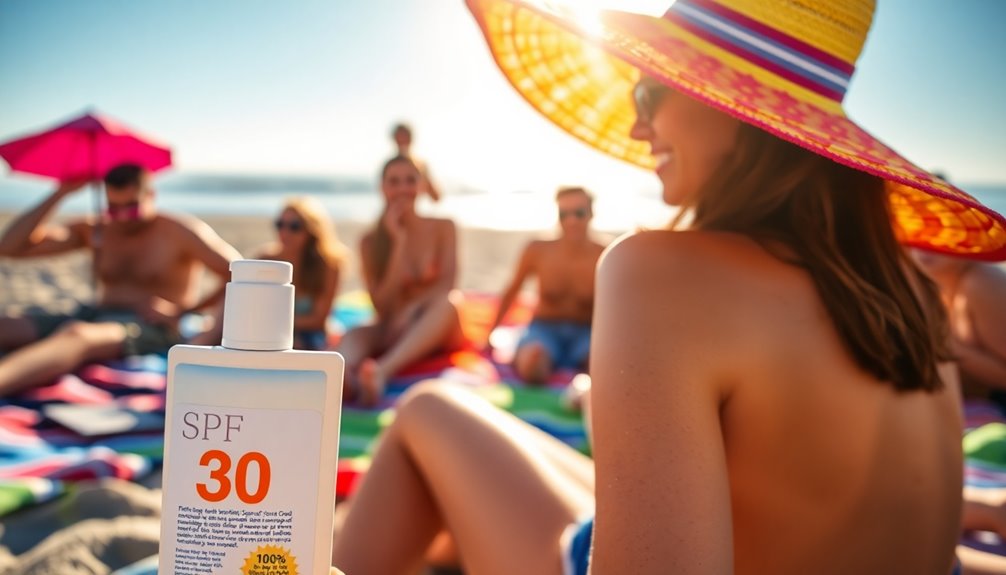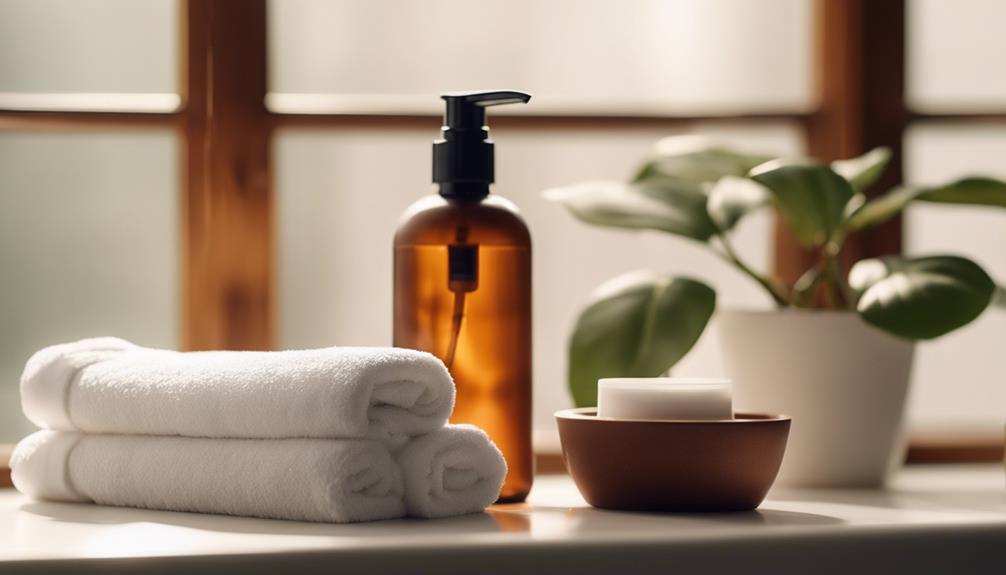SPF 30 isn't the ultimate sun shield you might think it is. While it effectively blocks about 97% of UVB rays, that still leaves a bit of room for trouble—especially since it doesn't provide full protection against UVA rays, which age your skin and can sneak in through windows! Experts recommend broad-spectrum sunscreens and reapplying every two hours, regardless of skin type. Plus, if you've got lighter skin or plan a long day outdoors, consider using SPF 50 for a little extra security. Stick around, and you'll uncover more sunscreen secrets that are essential for your skin's health!
Key Takeaways
- SPF 30 blocks about 97% of UVB rays, but SPF 50 offers slightly better protection at 98%, making higher SPF preferable for prolonged exposure.
- Regular use of broad-spectrum sunscreen is essential; SPF 30 alone does not guarantee complete protection against UVA rays, which cause deeper skin damage.
- Reapplication every two hours is crucial, as even high-SPF products lose effectiveness with sweating or swimming, regardless of the initial SPF rating.
- Many people apply only 25-50% of the recommended amount of sunscreen, significantly reducing its protective benefits; use at least one ounce for full coverage.
- Chemical sunscreens may pose health risks and harm marine life, so opting for eco-friendly, mineral-based formulations with zinc oxide is advisable for safety and sustainability.
The Science Behind SPF
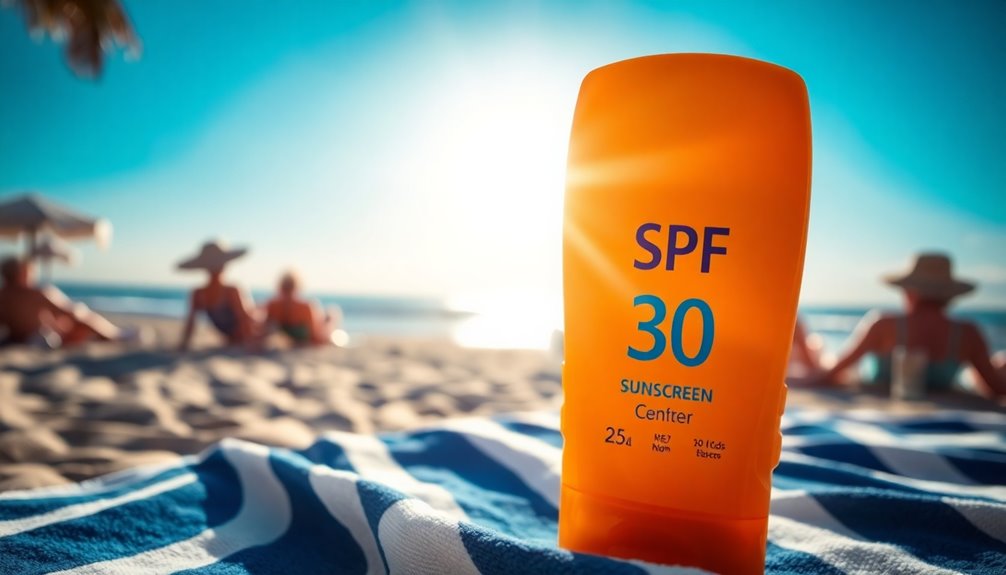
Understanding the science behind SPF is essential for anyone looking to protect their skin from harmful UV radiation. SPF, or Sun Protection Factor, measures how well a sunscreen protects against UVB rays, which are primarily responsible for causing skin damage. For instance, SPF 30 blocks about 97% of UVB rays, while SPF 50 offers about 98%. However, it's important to remember that no sunscreen can block 100% of UV radiation.
Many people apply only 25-50% of the recommended amount, which can greatly reduce the effectiveness of your sunscreen. Higher SPF numbers might give you a false sense of security, tempting you to stay in the sun longer without reapplication. That's why using broad-spectrum sunscreen is essential; it protects against both UVA and UVB rays, ensuring thorough coverage.
Research indicates there's minimal difference in protection between SPF 30 and SPF 50, so focusing on how you apply and reapply your sunscreen is key. When you head outdoors, don't just slap it on and forget about it—make reapplication part of your routine, and your skin will thank you!
Understanding UV Radiation
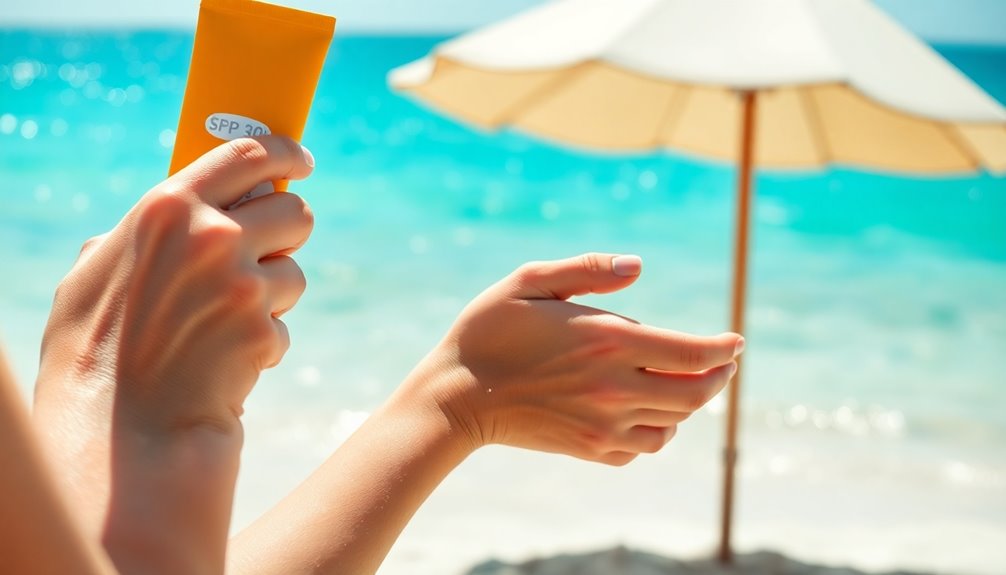
UV radiation poses a significant threat to your skin, and recognizing its different types can help you better protect yourself. UVB rays are the culprits behind sunburn and are closely linked to skin cancer, while UVA rays contribute to skin aging and can even damage the DNA in your skin cells. It's vital to know that UVB rays are most intense between 11 a.m. and 3 p.m. during summer, but don't let that fool you—UVA rays can penetrate glass, meaning you're still at risk indoors.
To keep things clear, here's a quick table to help you understand UV radiation better:
| UV Type | Effects on Skin | Protection Needed |
|---|---|---|
| UVA Rays | Aging & DNA damage | Broad-spectrum sunscreen |
| UVB Rays | Sunburn & skin cancer | Broad-spectrum sunscreen |
| Intensity | Varies by time & season | Check UV index |
| Indoor | Still a risk | Use sunscreen indoors |
Using broad-spectrum sunscreen is essential for protecting against both UVA and UVB rays. So, even if you think SPF 30 is enough, remember that regular sun exposure can lead to cumulative skin damage, increasing your risk of skin cancer over time. Additionally, studies on green tea's antioxidants suggest that they may help protect your skin from UV damage when consumed regularly.
Misconceptions About Sunscreen
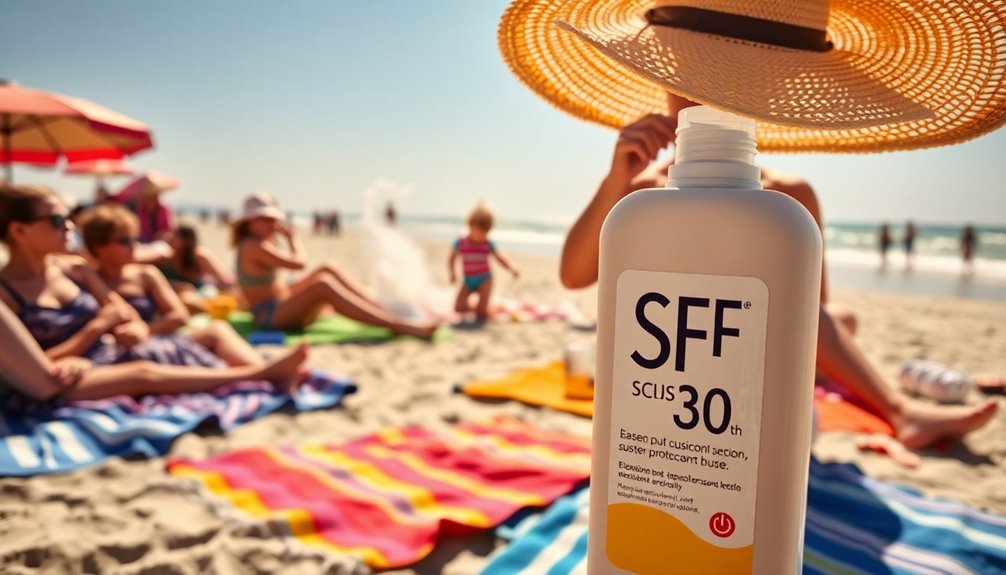
You might think SPF 30 has you fully covered, but that's a big misconception—it only blocks about 97% of UVB rays, so reapplying is key.
Plus, sunscreen isn't a one-and-done deal; you need to slather it on every two hours, especially after swimming or sweating, to keep that protection strong.
And don't forget, regardless of your skin tone, everyone can benefit from sunscreen, so let's clear up these myths and arm ourselves with the right knowledge!
SPF 30 Misunderstood Effectiveness
Many believe that SPF 30 provides ample protection from the sun, but this common misconception can lead to serious consequences. While SPF 30 theoretically allows for 300 minutes of sun exposure for someone who usually burns after just 10 minutes, the reality is far different. The effectiveness of SPF 30 hinges on how well you apply sunscreen.
Most people only manage to apply 25-50% of the recommended amount, which drastically reduces your protection and raises the risk of sunburn.
It's not just about slapping some lotion on; proper application is key. If you miss areas or don't apply evenly, those patches of skin become vulnerable to UVB rays, the culprits behind painful sunburns.
Higher SPF options, like SPF 50, can provide even better defense, especially considering common application errors. Plus, remember that SPF ratings come from controlled lab tests; real life—think sweating, swimming, or forgetting to reapply—can really diminish effectiveness.
Reapplication Myths Debunked
The common belief that a single application of sunscreen offers all-day protection is a myth that can lead to painful consequences. You might think that applying SPF 30 sunscreen just once is enough, but that's simply not true.
To maintain adequate protection against harmful UV rays, you need to reapply your sunscreen every two hours, especially after swimming or sweating.
Here are some common misconceptions about sunscreen reapplication:
- One-and-done: Applying sunscreen once won't keep you protected all day.
- Amount Matters: Most people apply only 25-50% of the recommended amount, increasing the risk of sunburn.
- SPF 30 is Foolproof: Even SPF 30 requires reapplication to maintain its effectiveness.
- Invisible UV Threats: UV rays can penetrate clothing and glass, so don't skip reapplication even if you're shaded.
Importance of Broad-Spectrum Protection
Broad-spectrum protection is vital for effective sun safety, as it shields your skin from both UVA and UVB rays. Many people mistakenly believe that just slathering on an SPF 30 sunscreen is enough for proper skin protection, but that's not the whole story.
While SPF measures UVB protection—those pesky rays that cause sunburn—UVA rays sneak in and can lead to skin aging and even cancer. Without the broad-spectrum label, your sunscreen might leave you vulnerable to these harmful effects.
It's important to remember that high SPF alone isn't your golden ticket to safety. Studies show that folks often apply sunscreen incorrectly, which can markedly reduce its effectiveness. So, even if you're using SPF 30 or higher, without broad-spectrum protection, you're not fully covered.
Choosing a broad-spectrum sunscreen guarantees that you block up to 97% of UVB rays while also guarding against UVA exposure, which often flies under the radar. Additionally, proper application techniques are crucial to ensure maximum protection and effectiveness of your sunscreen.
Best Practices for Application
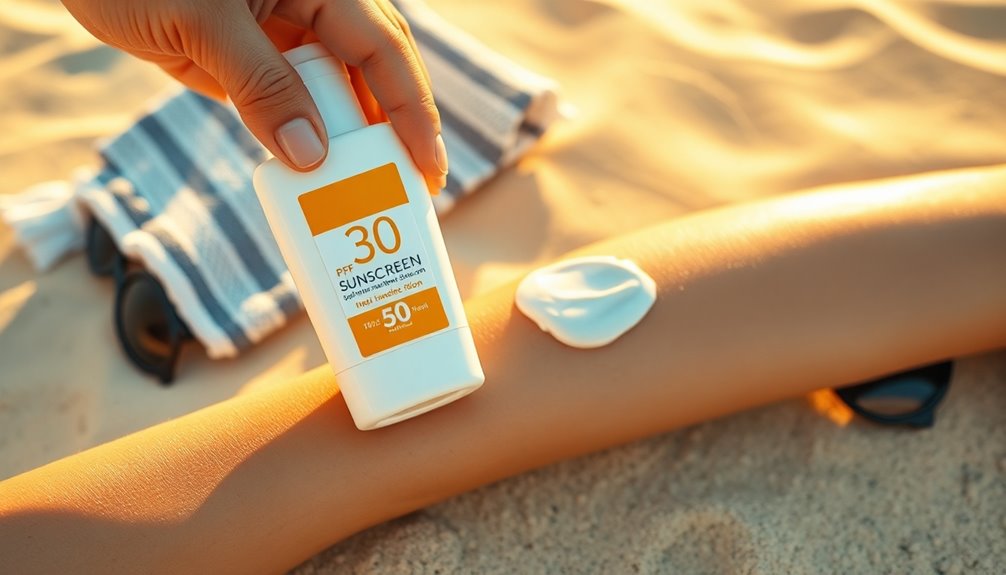
When heading outdoors, applying sunscreen correctly is essential for effective protection against harmful UV rays. Many people underestimate how much sunscreen they need, so here are some best practices to guarantee you get the coverage you need:
- Use at least one ounce (about a shot glass) for full body coverage. Most folks only apply about 25-50% of that!
- Apply 15-30 minutes before sun exposure, allowing your skin to absorb the sunscreen properly for maximum effectiveness.
- Reapply every two hours or immediately after swimming or sweating. Staying vigilant keeps those UV rays at bay.
- Don't forget tricky spots like your ears, feet, and the back of your neck. They're often missed, and we want to avoid any sunburn surprises!
Expert Recommendations on SPF
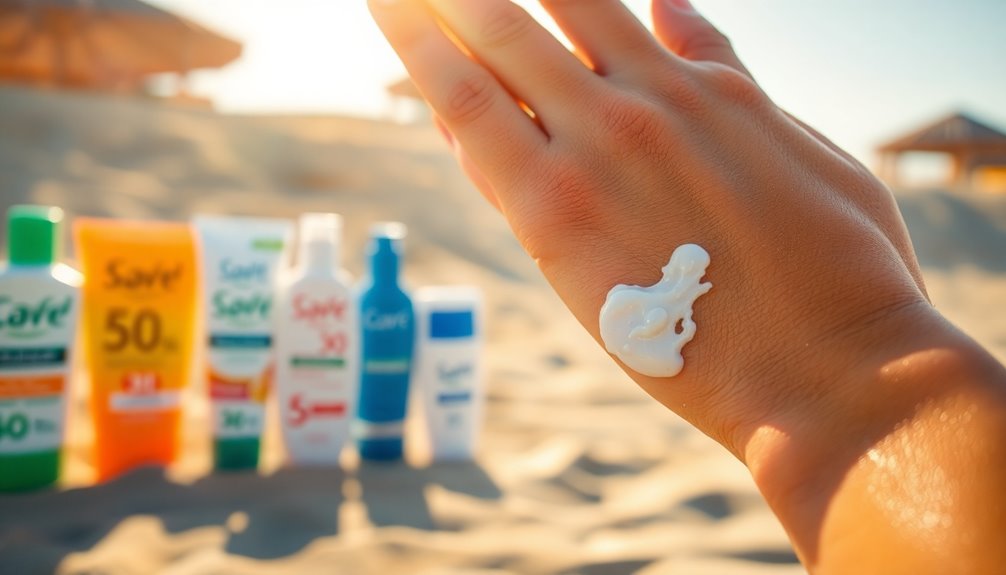
When it comes to choosing the right sunscreen, experts generally agree that you should aim for a minimum SPF of 30.
This level not only blocks about 97% of harmful UVB rays but also sets the stage for effective skin protection, especially when you reapply regularly.
Minimum SPF Recommendations
Most experts agree that using a minimum SPF of 30 is essential for effective sun protection. SPF 30 blocks about 97% of UVB rays, which can cause skin cancer over time. If you're fair-skinned or spend extended hours outdoors, consider opting for SPF 50 for extra protection.
But remember, the sun protection factor is only as good as its application.
Here are some key points to keep in mind:
- Apply enough sunscreen: Most people only use 25-50% of the recommended amount, reducing effectiveness.
- Reapply often: To maintain protection, reapply every two hours, especially if you're swimming or sweating.
- Choose broad-spectrum: Look for sunscreens that protect against both UVA and UVB rays for extensive coverage.
- Make it a habit: Regular use of SPF 30 or higher can greatly lower your skin cancer risk over time.
Importance of Broad-Spectrum
Using the right sunscreen is just as important as choosing an adequate SPF level. You might think that SPF 30 is enough, but without broad-spectrum protection, you're leaving yourself vulnerable to harmful UV radiation.
Broad-spectrum sunscreens shield you from both UVA and UVB rays. While UVB rays are mainly responsible for sunburn, UVA rays can sneakily contribute to skin aging and increase your risk of skin cancer.
Dermatologists recommend using a broad-spectrum sunscreen with at least SPF 30, as it effectively blocks about 97% of UVB rays. Additionally, hydrated skin can enhance your overall appearance and make your sunscreen more effective in protecting against UV damage.
Sure, SPF 50 offers slightly better protection, but don't let higher numbers give you a false sense of security. It's essential to pair your SPF use with other protective measures, like wearing hats or seeking shade.
Reapplication Guidelines Explained
To maintain effective sun protection, it's vital to reapply sunscreen regularly. Many people underestimate just how important reapplication is in safeguarding against harmful UV rays. You should apply sunscreen 15-30 minutes before heading outdoors, and then reapply every two hours. If you swim or sweat, don't forget to reapply immediately afterward. This guarantees you get the maximum SPF protection throughout your day.
Here are some key tips to keep in mind for ideal sunscreen use:
- Use at least one ounce of sunscreen, about the size of a shot glass, for full-body coverage.
- Pay special attention to often-missed areas like your ears, feet, and the back of your neck.
- Always check the expiration date on your sunscreen, as it typically expires after three years.
- Remember, even water-resistant formulas need reapplication to maintain their effectiveness. Additionally, consider your skin type, as different skin types may require tailored protection strategies to avoid overexposure.
Taking these steps seriously will help you enjoy the sun while effectively protecting your skin.
Navigating Sunscreen Ingredients
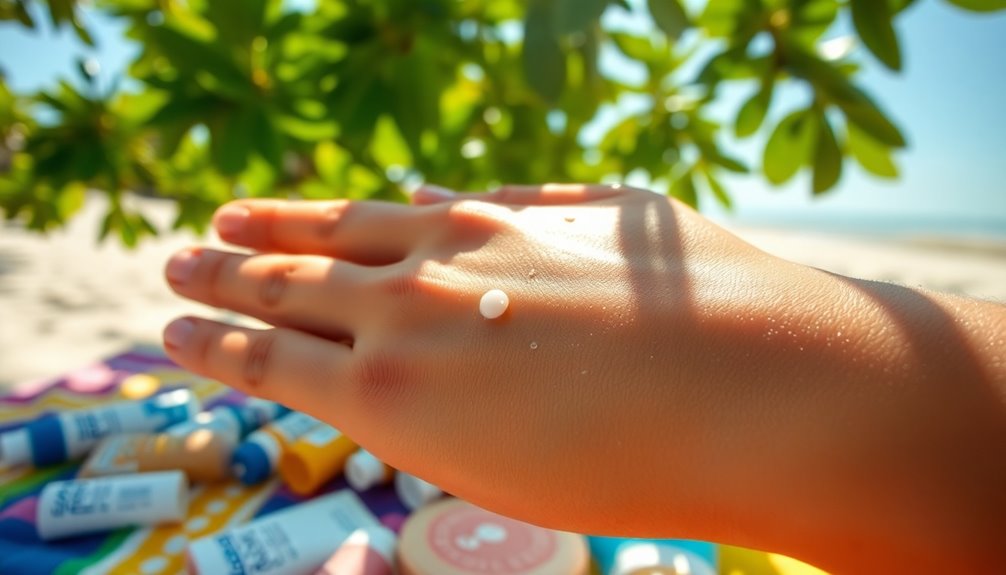
Choosing the right sunscreen can feel overwhelming with so many options and ingredients on the market. To simplify your search, focus on formulations containing zinc oxide and titanium dioxide. These physical blockers provide effective UV protection and are safer alternatives to chemical sunscreens like oxybenzone, which can disrupt hormones and possibly increase skin cancer risk.
Always check ingredient labels for harmful additives. For example, retinyl palmitate has shown potential risks in animal studies, so it's best to steer clear of it.
Opt for broad-spectrum products, which shield your skin from both UVA and UVB rays. Remember, UVA rays cause skin aging, while UVB rays are notorious for causing sunburn.
If you have sensitive skin, be cautious with chemical ingredients that might cause irritation or allergic reactions; a patch test can help avoid uncomfortable surprises.
Plus, consider eco-friendly and reef-safe formulations—they protect not just your skin but also the environment. These formulations are designed to reduce harmful chemicals that can damage marine life and ecosystems, making them a responsible choice for environmentally conscious consumers. In addition to using eco-friendly products, adopting sustainable hair texturizing techniques can further minimize your beauty routine’s ecological footprint. By opting for natural methods that require fewer resources, you can enjoy beautiful hair while supporting a healthier planet.
Frequently Asked Questions
Is SPF 30 Really Enough?
So, is SPF 30 really enough?
Well, it blocks about 97% of UVB rays, which sounds great, but here's the catch: most folks don't apply enough sunscreen!
If you're only using half the recommended amount, you're not getting that full protection.
Dermatologists often suggest going for SPF 50 or higher since it provides a bit more safety margin, especially if you're spending extended time in the sun.
Stay smart and lather up!
Does It Matter if You Use SPF 30 or 50?
When you're choosing between SPF 30 and SPF 50, it does matter!
SPF 30 blocks about 97% of UVB rays, while SPF 50 gives you around 98%.
That mightn't sound like much, but those extra percentages can be a game-changer, especially if you're prone to sunburn.
Plus, if you're not applying enough sunscreen, that higher SPF can help compensate for your under-application.
Can You Still Get Sun With SPF 30?
You might think SPF 30 offers solid protection, but the reality is a bit trickier. You can still get sunburned, especially if you're not applying enough or reapplying every two hours.
Even on cloudy days, UV rays sneak through, so don't skip that sunscreen. Remember, applying it properly is key—less is definitely not more in this case.
Is It Good to Use SPF 30 Sunscreen?
Using SPF 30 sunscreen can be a smart choice for daily activities, as it blocks about 97% of UVB rays.
However, if you're not applying enough—most folks only use half the recommended amount—you mightn't be getting that full protection.
Plus, don't forget to reapply every two hours!
For longer sun exposure or peak hours, consider bumping up to SPF 50.
Your skin will thank you for it later!
Conclusion
So, is SPF 30 enough? Well, think of it like a superhero cape—great for everyday wear, but it might not save you from every villain. While SPF 30 offers decent protection, it's essential to layer on enough, reapply often, and consider your unique skin needs. Don't let misconceptions lead you astray; your skin deserves better than a half-hearted defense. Stay informed, stay protected, and keep that glow—after all, no one likes a sunburnt hero!
